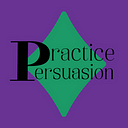The Art of Arguing
The difference between Rhetorics and Eristics
From Latin rhetorica as Justinian the Great said:
“Rhetoric (…) is the most wonderful of all arts.”
This art was adored by Aristotle, Seneca, Cycero and many more ancient philosophers and writers, even nowadays.
Rhetoric is an art of building artistical, persuasive statement in order to get to get to receiver by logic (logos), emotion (pathos), credibility (ethos).
Now the Eristics something brought up by Arthur Schopenhauer in 1891 in his book “Eristic Dialectic: The Art of Winning an Argument”.
Eristic is an art of arguin till beneficial solution, no matter of the material truth. Original Greece word (eristikós) means quarrelsome from ancient goddess of disagreement.
But what’s the real difference between these two ?
Well as you might already read the disparity could be closer than we see.
Like father, like son
The primary difference here is that Eristic doesn’t have something different than so called “rhetorical triangle”.
The Eristic have only 2 concepts, one which is logic (quite obvious I hope I don’t have to explain), and the second dialectic.
Dialectic is described as a form of talking or common reasoning so as, to keep the appearance of truth.
Per fas et nefas — By all permitted and prohibited means
If anyone of you is interested in Schopenhauer’s literature you might know that his point of view was rather pessimistic, to the human nature.
He states that people are evil, dishonest, vain and talkative.
Quite sad but sometimes, all of us have to agree.
Who actually uses it ?
Schopenhauer gives us 32 methods which he consideres as “unfair eristic dialectic”.
Now we won’t bring up every single method because some of them are incorrect or old dated.
However, there are some examples which can be seen in our normal conversations or in a job.
1. Generalization (insantia)
Expanding the speech of our enemy outside the border of our thinking.
You could also take it as deductive reasoning which means if A=B, B=C, C=D, then A=D.
There is also famous “so you’re saying”, used many times by journalists.
What they’re doing is creating a trap and misreading for purpose some of your words, in order to frame you by your own words.
2. Giving scattered premises (including incorrect ones)
It is something which, I would name as a hidden attack.
You’re basically gathering all of your thesis or premises, and then at the very end, when your opponent agreed to most of your words you crush him with your conclusion which he won’t agree at the beginning.
This is more of like if A=A, B=B, C=C and D=D then A+B+C+D=E.
(The sign of equal means the other person agrees with us).
3. Argumentum ad hominem (Argument to man)
Searching in the discussion contradiction to his morals by race, country or gender.
For example:
“And you, an Englishman, say such thing !?”
4. Socratic Method
Method of ironic incompetence.
You can also describe it as playing fool in conversation.
For instance if someone would gave us a tough to answer argument which was too elaborated and we can’t find any contrarguments against that, we can say for example:
“What you’re saying highly goes beyond limit of my poor understading, therefore I can’t say if you’re right or wrong. “
What a sneaky way to end the argumentation !
The fun part of it is that if you’re respected in your community and the other speaker might be not, the audience won’t give the credit to the winners, why ?
Because they don’t know who won !
Sometimes, support is sought in one’s own authority, not in reasons.
Keep that in mind.
Alright these are only 4 methods which could be useful for your future argumentation with your boss, coworker or anyone else.
These are only 4 methods of Eristics, remember that there is 28 more.
So if you want to explore more features of sneeky art of arguing, you can buy a book which I named above or wait for my next publication which will be soon :)
Stay tuned, have a Great Day and don’t get manipulated by others.
Cheers
